Excel wildcards got you feeling lost in a sea of data? You’re not alone. Many Excel users struggle with harnessing the power of these special characters to quickly find, filter, and analyze information in their spreadsheets.
Picture this: you’re working on a massive Excel file, and you need to locate all entries that start with “Mod” – like “Moderna” or “Modafinil.” Or maybe you want to count all cells that contain a specific word, regardless of what comes before or after it.
That’s where wildcards come in. These little symbols can save you hours of manual searching and filtering. In this comprehensive guide, we’ll walk you through everything you need to know about mastering wildcards in Excel – from the basics of what they are and how they work, to advanced techniques for using them in formulas, filters, and more.
Get ready to become an Excel wildcard wizard!
Key Takeaways
- Excel has 3 powerful wildcard characters: asterisk (*) matches any number of characters, question mark (?) matches any single character, and tilde (~) acts as an escape character for literal asterisks or question marks in data. You can use them to search for and manipulate data matching a specific pattern.
- Wildcards are very useful with Excel functions like COUNTIF and VLOOKUP for partial matching. For example, the formula “=COUNTIF(A1:A10,”Pf*”)” counts all cells in range A1:A10 that start with “Pf”. You can also combine wildcards with IF, ISNUMBER and SEARCH functions for more advanced matching.
- To use wildcards with numbers in Excel, first convert the numbers to text format using the TEXT function or changing cell format to text. This allows wildcards to match numbers as characters. For dates, combine wildcards with the TEXT function to match specific date formats or digits.
Understanding Excel Wildcard Characters
Excel wildcard characters are special symbols that act as placeholders, allowing you to search for and manipulate text strings that match a specific pattern. The asterisk (*), question mark (?), and tilde (~) are the three wildcard characters in Excel, each serving a unique purpose in finding, replacing, or filtering data.
Asterisk
The asterisk (*) is a powerful wildcard character in Microsoft Excel. It represents any number of characters in a cell. For example, if you want to find all cells that start with “Pf” like “Pfizer”, you can use the formula “=COUNTIF(A1:A10,”Pf*”)”.
This will count all cells in the range A1:A10 that begin with “Pf” followed by any number of characters.
The asterisk is the Swiss Army knife of Excel wildcards.
The asterisk wildcard is often used with Excel functions like VLOOKUP, HLOOKUP, and XLOOKUP for partial matching. If you have a list of email addresses and want to look up a specific domain, you could use a formula like “=VLOOKUP(“*@example.com”,A1:B10,2,FALSE)”.
Question mark
Another important wildcard character in Excel is the question mark (?). It matches any single character in a cell. For example, searching for “Mar?h” would find “March”, “Marsh”, or “Marth”.
The question mark proves useful when you know most of the characters in a cell but are unsure about one or a few of them. It allows for more specific searches compared to the asterisk, which matches any number of characters.
Whether you’re working with text, numbers, or dates, the question mark wildcard can help pinpoint the exact data you need.
Tilde
In Excel, the tilde (~) serves as an escape character for wildcards. It allows you to search for the literal asterisk (*) or question mark (?) in your data. For example, if you want to find cells containing “~*” or “~?”, simply type “~~*” or “~~?” in the Find box.
The tilde negates the special meaning of these characters, treating them as regular text.
Using the tilde is crucial when working with data that includes asterisks or question marks. Without it, Excel would interpret these symbols as wildcards and return unintended results.
Excel Find and Replace with Wildcards
Excel’s Find and Replace feature with wildcards makes searching and replacing data a breeze. You can quickly locate and update specific patterns or partial matches in your spreadsheets, saving time and effort.
How to Search with Wildcards
Searching with wildcards in Excel is a powerful way to find specific data quickly. It allows you to locate information even if you don’t know the exact text or values. Here’s how to search with wildcards in Excel:
- Asterisk (*): Use the asterisk to represent any number of characters. For example, searching for “s*t” will find “sat”, “seat”, “start”, etc.
- Question Mark (?): The question mark represents a single character. Searching for “s??t” will find “seat” and “silt” but not “sat” or “start.”
- Tilde (~): If you need to search for a wildcard character literally, precede it with a tilde. Searching for “~*” will find cells containing an actual asterisk.
- Open the Find and Replace dialog box by pressing Ctrl+F or clicking Find & Select > Find on the Home tab.
- Enter your search term with wildcards in the “Find what” field. For instance, to find cells starting with “A” and ending with “Z”, enter “A*Z”.
- Click on Options and select “Match entire cell contents” if needed. This ensures Excel matches the whole cell value, not just a part of it.
- Choose “Look in” to specify whether to search in formulas, values, or comments. “Values” is the default.
- Click Find All to see a list of all cells matching your wildcard search. You can then select any cell from the results to jump directly to it.
- The Formula Bar displays the actual cell contents for each result, allowing you to verify matches easily.
- If desired, you can replace some or all of the found values. Enter the replacement text in the “Replace with” field and click Replace or Replace All.
By mastering wildcard searches, you can quickly locate and manipulate data in large Excel spreadsheets. It’s a valuable skill for any Excel user looking to boost productivity.
How to Replace with Wildcards
Replacing text with wildcards in Excel is a powerful technique. It allows you to make bulk changes to your data quickly and easily. Here’s how to replace with wildcards in Excel:
- Open the workbook and select the range of cells where you want to make replacements. You can also press Ctrl+A to select the entire worksheet.
- Press Ctrl+H or go to Home > Editing > Find & Select > Replace to open the “Find and Replace” dialog box.
- In the “Find what” field, enter the text or pattern you want to find. Use the wildcard characters (?, *, ~) as needed to represent unknown characters.
- In the “Replace with” field, enter the replacement text. You can also use wildcard characters here if needed.
- Click on Options to expand more settings:
- Click Replace All to replace all occurrences at once. Or click Find Next to locate the first instance, then click Replace to change just that occurrence. Keep clicking Find Next and Replace to step through one by one.
- A dialog box will appear showing how many replacements were made. Click OK to close it.
- Save your workbook to preserve the changes. Use Save As and choose a different file name if you want to keep the original unaltered.
Excel Wildcards in Formulas
Excel wildcards can supercharge your formulas, letting you match partial text and numbers. The COUNTIF and VLOOKUP functions pair perfectly with wildcards to find and tally cells that fit specific patterns.
Excel COUNTIF Wildcard Formula
The COUNTIF function in Excel is a powerful tool for counting cells that meet specific criteria. It becomes even more versatile when combined with wildcard characters like the asterisk (*) and question mark (?).
The asterisk represents any number of characters, while the question mark stands for a single character. For example, the formula =COUNTIF(A1:A11,”?*”) counts cells in the range A1:A11 that contain any text, regardless of length.
This is useful for quickly identifying non-empty cells or cells that follow a certain pattern.
By leveraging wildcards with the COUNTIF function, you can count cells that match partial text or specific patterns. This is particularly handy when dealing with large datasets or inconsistent data entry.
For instance, =COUNTIF(B1:B20,”*apple*”) counts all cells in the range B1:B20 that contain the word “apple” anywhere within the cell. Similarly, =COUNTIF(C1:C30,”1?”) counts cells in the range C1:C30 that start with the digit “1” followed by any single character.
Excel VLOOKUP Wildcard Formula
Building on the COUNTIF wildcard formula, let’s explore the VLOOKUP wildcard formula in Excel. This powerful combination allows you to search for partial matches in a lookup table and return the corresponding value from another column.
By incorporating the asterisk (*) or question mark (?) wildcards, you can perform fuzzy matching even when you don’t have the exact lookup value.
The syntax for the VLOOKUP wildcard formula is similar to the standard VLOOKUP, with the addition of the wildcard characters in the lookup_value argument. For example, to find a product name that contains the word “shirt,” you can use the formula =VLOOKUP(“*shirt*”, table_array, column_index_num, FALSE).
Using Wildcards in Excel Filters
Excel’s filter feature is a powerful tool for sorting and analyzing data. You can take it to the next level by using wildcards in your filters. Wildcards allow you to match partial text or numbers, giving you more flexibility in finding the information you need.
To use wildcards in Excel filters, simply type the wildcard character along with your search term in the filter field. The asterisk (*) matches any number of characters, while the question mark (?) matches a single character.
For example, filtering for “s*” would return all entries starting with “s”, while “s???h” would match “smith” and “south”. With a bit of practice, wildcards can become a valuable addition to your Excel toolkit, helping you quickly drill down to the data that matters most.
Excel Wildcards in IF Statement
With Excel IF statements and wildcards, you can search for partial matches in your spreadsheets—unlocking a world of possibilities for data analysis and manipulation. From finding specific numbers to matching dates and text, wildcards in IF formulas give you the power to zero in on the information you need.
Keep reading to discover how to supercharge your Excel skills with these game-changing techniques!
IF ISNUMBER SEARCH formula for partial matches
The IF ISNUMBER SEARCH formula in Excel is a powerful tool for finding partial matches in your data. It combines the IF function with ISNUMBER and SEARCH to check if a cell contains specific text, even if it’s not an exact match.
This formula returns TRUE if the search text is found and FALSE if it’s not, allowing you to perform logical operations based on the presence of certain text patterns.
To use the IF ISNUMBER SEARCH formula, simply enter the search text as the first argument in the SEARCH function, the cell or range to search in as the second argument, and the value to return if the text is found as the third argument in the IF statement.
IF OR statement with wildcards
The IF OR statement with wildcards in Excel allows you to check for multiple conditions within a cell. It’s a powerful way to categorize data based on partial matches. For example, you can use an IF OR formula with wildcards to classify products by their SKUs, even if the SKUs have slight variations.
The formula would look something like
=IF(OR(ISNUMBER(SEARCH("ABC*",A1)),ISNUMBER(SEARCH("XYZ*",A1))),"Category 1","Category 2"). This checks if the cell contains either “ABC” or “XYZ” followed by any characters, and returns “Category 1” if true, or “Category 2” if false.
Combining the IF function with the OR operator and wildcard characters like asterisks (*) or question marks (?) gives you immense flexibility in Excel. You can nest multiple ISNUMBER and SEARCH functions within the OR statement to check for various conditions simultaneously.
This approach is invaluable when dealing with large datasets that require complex categorization rules. By leveraging wildcards in your IF OR formulas, you can streamline your data analysis process and make more informed decisions based on specific criteria.
IF AND formula with wildcards
The IF AND formula with wildcards in Excel allows you to create powerful logical tests. It checks multiple conditions simultaneously, giving you granular control over your data validation.
For instance, you can use the IF AND formula to check if a cell contains specific text patterns using wildcards like the asterisk (*) or question mark (?). This comes in handy when you need to filter or highlight data based on complex criteria.
To use the IF AND formula with wildcards, combine the IF function with the AND operator and wildcard characters in your logical tests. The formula will return one value if all the conditions are true, and another value if any of the conditions are false.
IF statement for partial text match
Transitioning from IF AND formulas with wildcards, let’s explore how to use IF statements for partial text matches in Excel. The SEARCH function comes in handy here. It checks if one text string appears within another.
By combining IF and SEARCH, you can test whether a cell contains specific characters and return different values based on the result.
For instance, to categorize product names as either “Hardware” or “Software” based on partial matches, you could use a formula like:
=IF(ISNUMBER(SEARCH("Drill",A2)),"Hardware",IF(ISNUMBER(SEARCH("License",A2)),"Software","Other"))Practical Examples
We’ll explore real-world cases that show how wildcards make Excel tasks easier. Discover how to use them with numbers and dates to speed up your workflow.
Example 1: Excel wildcard formula for numbers
Here’s an Excel wildcard formula example for numbers. Let’s say you want to count cells that contain specific digits, like all numbers with “25” in them (125, 2500, 7825). The COUNTIF function alone can’t handle this, as it treats numbers as numeric values, not text.
To make it work, use the SUMPRODUCT function with wildcards. First, convert the numbers to text using TEXT(A2,”0″). Then, use wildcards within SUMPRODUCT, like this:
SUMPRODUCT(--ISNUMBER(SEARCH("*25*",TEXT(A2:A10,"0")))).This formula looks for “25” within the text-converted numbers and counts the matches. With creative uses of Excel functions and wildcards, you can unlock powerful ways to analyze numeric data.
Example 2: Wildcard formula for dates
After learning how to use wildcard formulas for numbers, let’s explore their application in working with dates. Excel’s wildcard functionality extends to date-based data, allowing you to perform searches and calculations based on specific patterns or criteria.
One common use case is counting dates that contain certain digits or follow a particular format. By combining the wildcard characters with the TEXT function, you can convert dates into a suitable format for pattern matching.
For instance, to count dates in the format “MM/DD/YYYY” where the day is either 01 or 15, you can use a formula like:
=COUNTIF(A1:A10,"??/[01,15]/????")This formula leverages the question mark (?) to represent any single character and the square brackets ([]) to specify a set of possible values.
Example 3: Using the Asterisk (*) Wildcard in Excel for TEXT Cells
The asterisk is a wildcard for any text in the search for matching cells. When used on its own as in this case it returns any cell with text.
On its own it therefore excludes all blank cells (as well as excluding any numeric cells). Again this can be a useful validation. While the example above was checking for blank cells, this time we’re also excluding numeric values from the result.
The rows summed are shown in yellow.
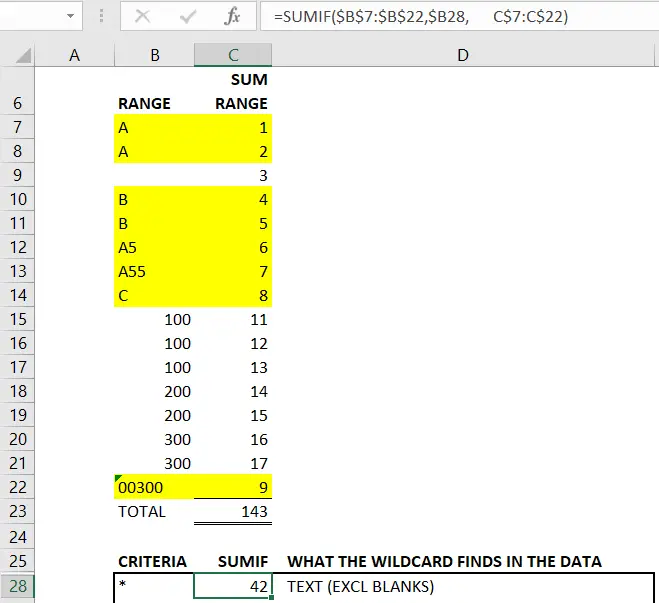
Example 4: Using the Wildcard Asterisk (<>*) in Excel for NON-TEXT Cells
Now if we add ‘<>’ to the asterisk wildcard we can get the opposite result. So ‘<>*’ will return a sum of all the numeric cells (including any blanks in the range).
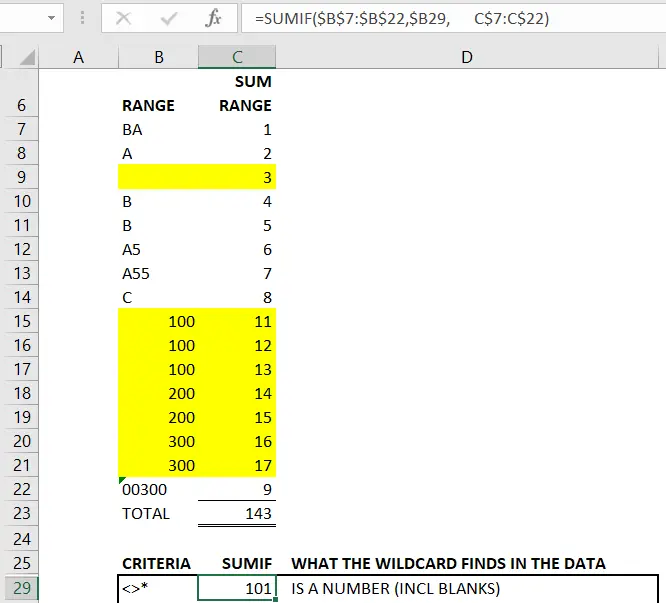
Example 5: Using the Asterisk (*) Wildcard with Text in Excel [criteria *A* = text with ‘A’ somewhere in string]
Lets check our list for ‘*A*’. This is one of the most common uses of wildcards in Excel, particularly with VLOOKUP or SUMIF. You can see below that anything with ‘A’ is found and the range in column C is summed. This is not case sensitive.
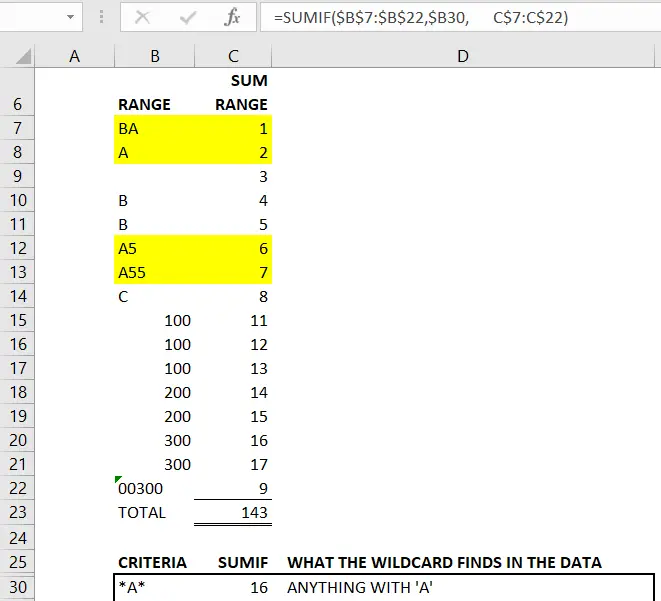
Troubleshooting Common Issues
Wildcards may not work with numbers in Excel due to specific settings. If your IF function with a wildcard isn’t working, double-check your syntax and ensure you’re using the correct wildcard characters.
Why Excel Wildcard May Not Work with Numbers
Excel wildcards don’t work directly with numbers due to how the program stores and handles numerical data. Numbers are kept in a binary format optimized for calculations rather than text searches.
This storage method makes it impossible for Excel to interpret numbers as strings when conducting wildcard searches.
To use wildcards with numbers in Excel, you must first convert the numerical data to text format. This conversion allows Excel to treat the numbers as characters, enabling wildcard functionality.
How to Enable Wildcards for Numbers
To enable wildcards for numbers in Microsoft Excel, you’ll need to convert the numbers to text first. This allows you to apply regular formulas like VLOOKUP, COUNTIF, and MATCH with wildcards to your numerical data.
Here’s how to convert numbers to text and enable wildcards:
- Select the range of cells containing the numbers you want to convert.
- Click on the “Data” tab in the Excel ribbon.
- In the “Data Tools” group, click on “Text to Columns.”
- In the “Convert Text to Columns Wizard,” select “Delimited” and click “Next.”
- Uncheck all the delimiter options (Tab, Semicolon, Comma, Space, and Other) and click “Next.”
- In the “Column data format” section, select “Text” and click “Finish.”
- Your numbers are now converted to text, and you can use wildcard characters like asterisk (*) and question mark (?) in your formulas.
For example, to count the number of cells that start with “123” using the COUNTIF function, you can use the formula: =COUNTIF(A1:A10,”123*”)
This technique expands the possibilities of using wildcards in various numerical contexts, such as filtering, searching, and manipulating data based on partial matches or specific patterns.
By converting numbers to text, you gain more flexibility in working with wildcards across your Excel spreadsheets, enabling you to perform complex lookups, comparisons, and calculations with ease.
Next, let’s explore some practical examples of using Excel wildcard formulas for numbers.
Why your Excel IF Function with Wildcard May Not be Working
The Excel IF function doesn’t natively support wildcards like asterisks (*) or question marks (?). Trying to use them directly in an IF statement will lead to errors or unexpected results.
The IF function treats wildcards as literal characters instead of special operators for pattern matching.
To work around this limitation, you need to combine the IF function with other functions that handle wildcards, such as COUNTIF or SEARCH. These functions can check if a cell’s value matches a wildcard pattern and return a numerical result.
Conclusion
Congratulations! You’ve reached the end of this comprehensive guide on mastering wildcard characters in Excel. We’ve covered the essential wildcard symbols, their usage in various Excel functions, and practical examples to help you grasp the concepts.
Wildcards are powerful tools that can save you time and effort when working with large datasets or complex formulas. Whether you’re searching for specific patterns, filtering data, or performing advanced calculations, wildcards can simplify your tasks and enhance your Excel skills.
So, are you ready to put your newfound knowledge into practice? Start exploring your own datasets and see how wildcards can streamline your workflow. With a bit of practice and experimentation, you’ll soon become a wildcard expert, tackling even the most challenging Excel tasks with ease.
Happy Excel-ing!

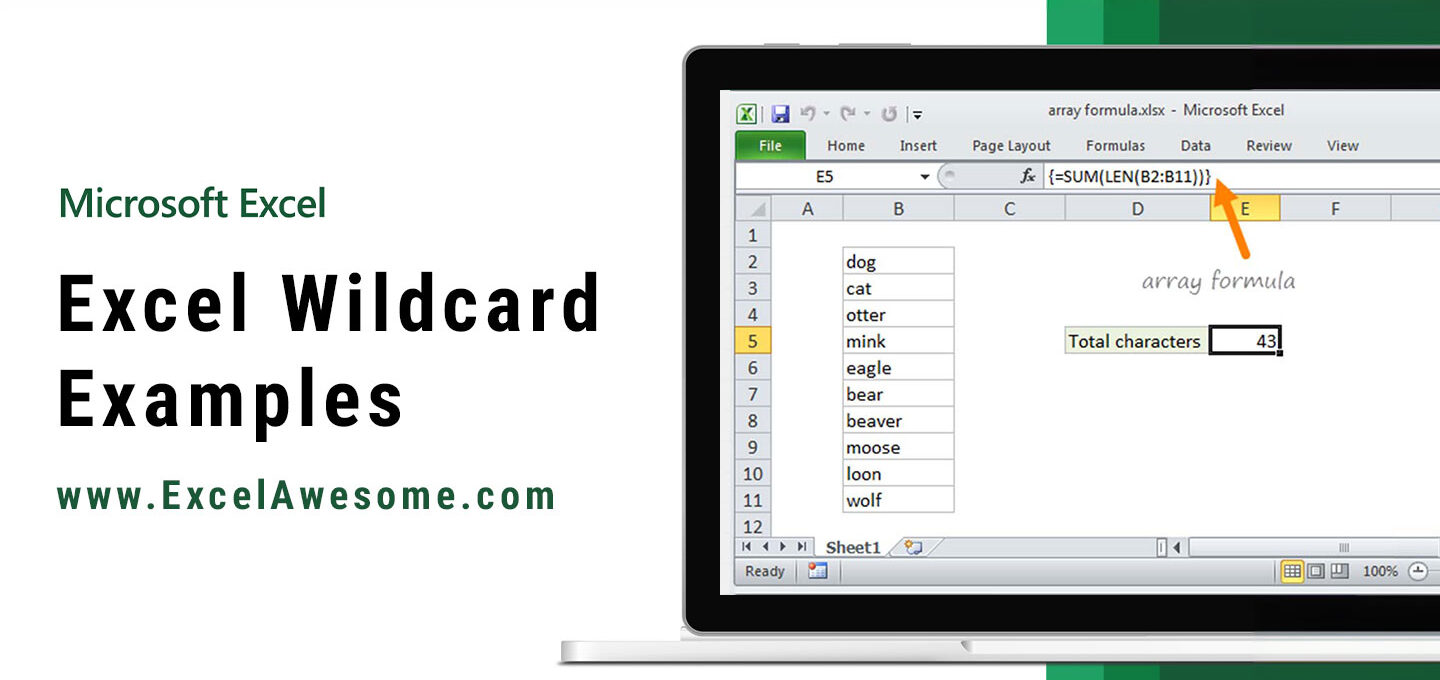
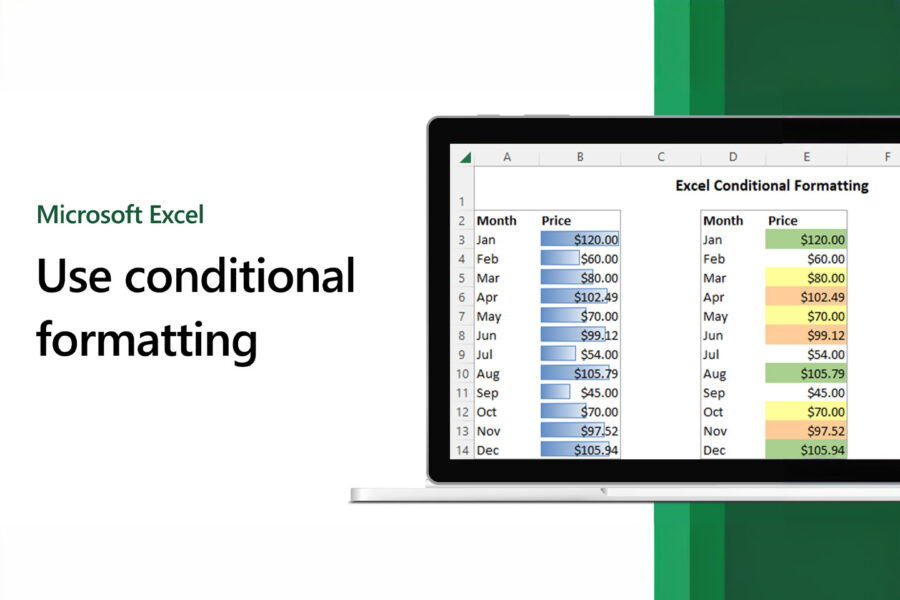
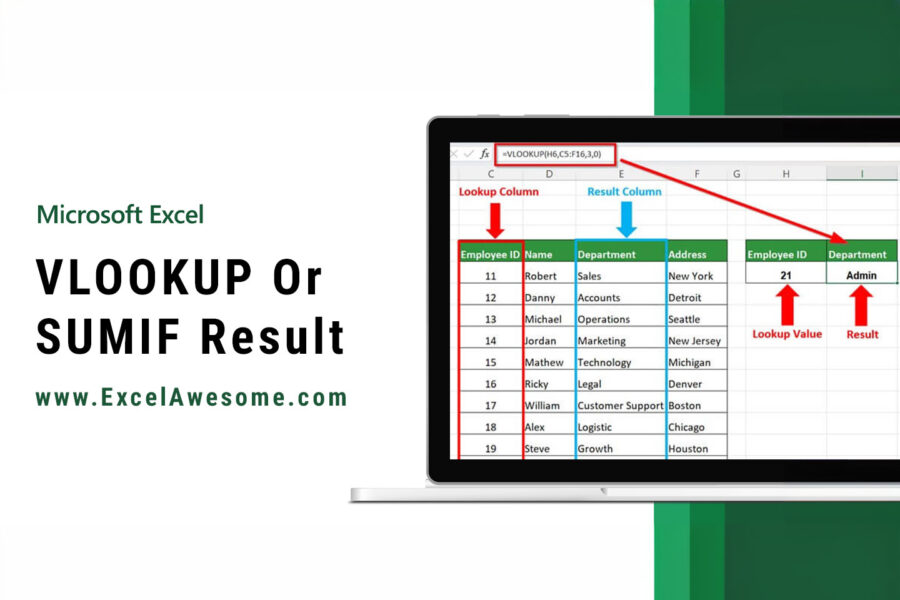
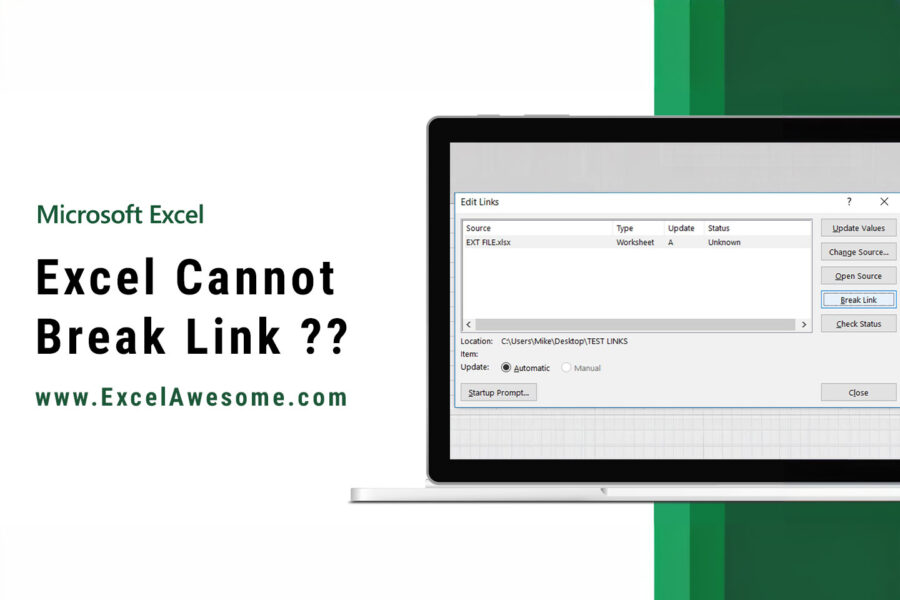
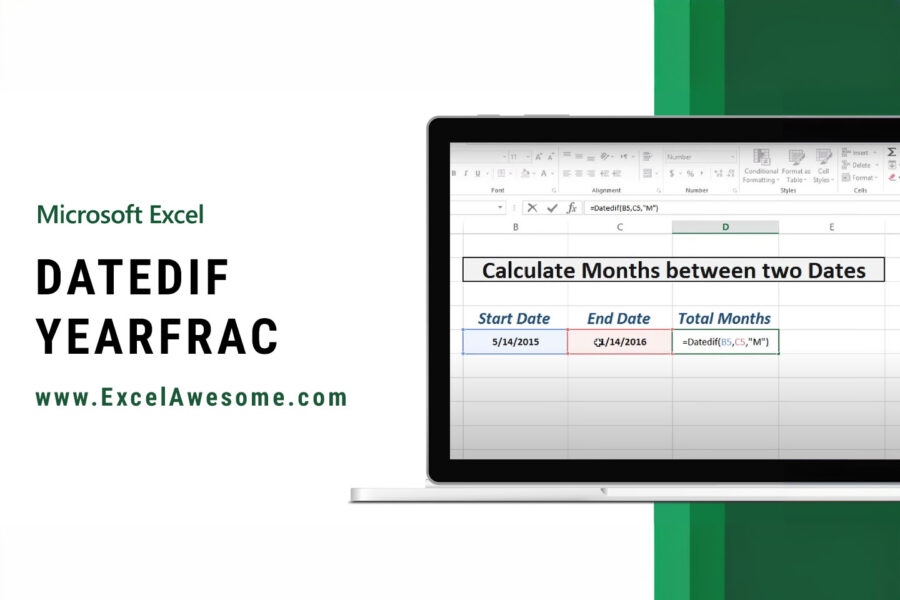
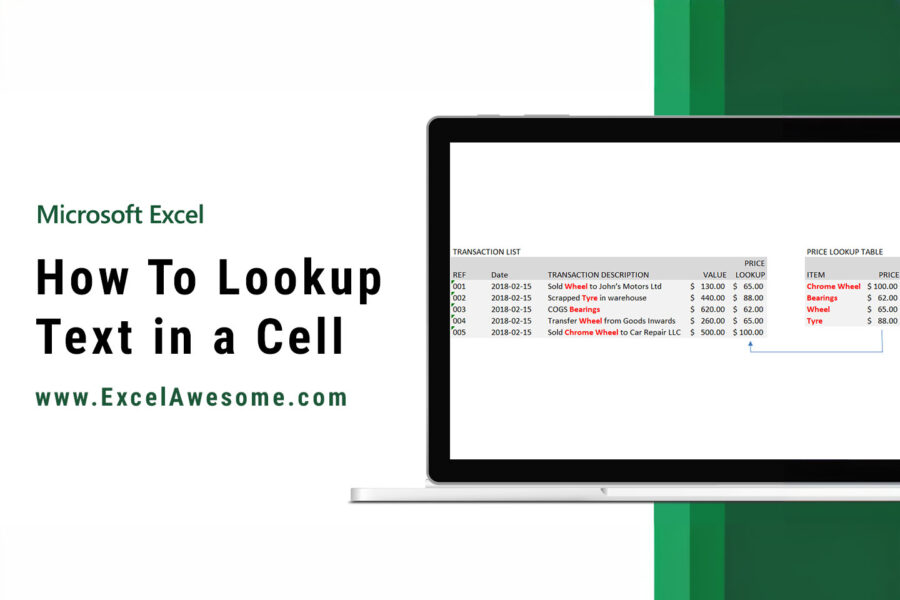
Leave a Comment